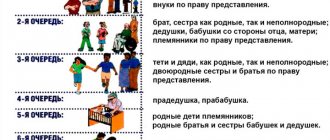When family life develops according to ideal canons, like: “they lived happily ever after and died on the same day,” jointly acquired property is a source of wealth and joy in the family. If life together does not work out and the spouses get divorced, it becomes a curse.
While separating cups, spoons and other movable belongings is still relatively easy, when it comes to real estate, people are simply stumped.
How to divide something that at first glance seems indivisible? An apartment? Dacha? House? The section of a private house in which a family permanently lives raises especially many questions. They pour in literally as if from a cornucopia:
- How to understand who is entitled to what share?
- Are spouses' shares always equal?
- What if the house was inherited by one of the spouses?
- What if it was registered in the name of one of the spouses, and the other spouse was involved in the construction and arrangement, or both together?
- What to do if, in addition to the husband and wife, children live in the residential property?
- What if one of the children is disabled?
- Is it possible to divide not only the monetary equivalent of the house, but also the premises itself, in fact?
- What methods of division exist?
And these are not all the questions that arise. In this article we will try to most fully illuminate the problem of dividing a private home during a divorce from a legal and practical point of view.
Home ownership
Russian civil legislation contains the concept of joint ownership. Family is a specific concept of common family members, in particular spouses. As for the husband and wife, everything that each of them buys or acquires during the marriage (except for inheritance and property received as a gift, but more on that below) is included in the joint property of the spouses.
At the same time, the termination of a marriage does not in itself become the reason for the termination of the fact of joint ownership of property. For example, after a divorce, the house still remains shared. And it will remain so for an indefinite time until it is divided legally.
That is, spouses can still reach mutual agreement and jointly dispose of the common house, or make a fair division, and then each dispose of their share (part).
ATTENTION! Joint property of spouses does not apply to children! That is, a house that belongs to the parents does not belong to the children (unless it was purchased or built with the participation of maternal capital).
This issue is regulated by Article No. 60 (clause 4) of the RF IC, and children are not subjects of the division of family property, regardless of whether the parents divide it due to divorce or just like that (according to the legal norms of the Russian Federation, spouses can divide property among themselves, without dissolving the marriage).
Community property in a marriage does not mean that either spouse cannot have personal property. For example, property donated by spouses to each other or to some third party is considered the personal property of the recipient of the gift and is not subject to division. The same applies to inheritance received under a will or line of succession. As well as property that the husband or wife owned before marriage.
Although, when it comes to home, there may be options. For example, before marriage, the wife had a plot of land with a dilapidated “barn”. During his family life, the husband, investing his earned money and personal labor, contributed to turning it into a comfortable estate. Such a house may be classified as joint property because the value of the property has increased significantly during the marriage. Such issues are resolved in court.
Conditions for the section
- All owners agree. In some cases, they may put forward their own requirements or preferences regarding the continued residence of several people in one house divided into several apartments. If you need to reach an “amicable” agreement, these requirements should be taken into account.
- A plot of land of sufficient size for division. Any house divided into several separate apartment blocks is located on land, which is also subject to division. Moreover, each apartment should not only have access to the site, but also access to the street. In some cases, it is allowed to use a common area for everyone through which access to the street is made. The size of the plot in such a situation plays a major role, since according to the Land Code, it cannot be less than a certain size. The numbers vary from region to region. In practice, only in rare cases is the plot size so small that it is not enough to divide a house.
- Correct location of the house. Ideally, there should be a relatively large area on each side through which you can go outside.
- The maximum permissible number of storeys for converting a private house into a blocked one with the division of premises into separate apartments is 3 floors.
- One private house cannot be divided into more than 10 apartment blocks.
Dividing a house into apartments is possible only if all the above conditions are met. Otherwise, it will be almost impossible to achieve division.
Example : The house is located on the edge of the plot. It can be divided into two apartments, providing each with a separate exit from two sides of the house that are not adjacent to the edge of the plot. But dividing it into three apartments will be more difficult, since in this case the division of the premises and the site must be carried out in such a way that each individual apartment has its own access to the site and to the street.
Ways to divide a house. Agreements or court
Like most issues regulated by the RF IC, the problem of dividing a private house can be solved in two ways:
- Agree privately among yourself and draw up an appropriate notarial agreement that will have full legal force
- Draw up a statement of claim and allow the court to resolve insurmountable differences between spouses, based on legislative norms and rules
Let's look at both methods in a little more detail.
Agreement
The husband and wife independently determine the shares that each of them receives in the event of a divorce. According to the rules, they should be equal. However, spouses can also agree on unequal shares, taking into account, for example, children.
Although from the point of view of the law, children do not have the right to parental property, the law does not prohibit parents from taking their interests into account privately.
For example, a spouse leaving the family may transfer his share to the children in lieu of monthly alimony payments. Or leave the spouse, with whom the children live, a larger share in the house. Simply put, by agreement, spouses can agree on any method of dividing the house, or reimbursement of part of its value by the one who will continue to live in it.
This method is convenient and preferable in the sense that the internal affairs of a family (even if broken up) remain its internal affairs and do not require the intervention of government bodies. But it can only be applied when the conflict between divorcing spouses has not reached the “extreme boiling point” and people are still able to communicate constructively with each other.
Court
If the husband and wife cannot agree or suspect that the other party “wants to deceive them,” they will have to resort to the help of the court. One of the home owners, or both together, can sue. In this case, a joint statement is written.
It is better to submit an application to the territorial court at the location of the house (especially if it is joint). If one of the spouses files a lawsuit, he can do so at the place of residence of the other (the defendant).
Dividing a house does not have to happen at the same time as the divorce process. You can do this in advance, or, conversely, after the divorce. You have the right to choose a mode that is convenient for yourself, and you should do so.
For example, if the divorce is complex and is accompanied by several claims for alimony, the place of residence of children, and the order of meetings with them, it is better not to complicate the already complicated process with an additional claim, but to postpone the section “for later.” If there are no particular disagreements, it would be optimal to “sue” at one time, so as not to repeat the entire unpleasant procedure again.
How to divide a plot of land and a residential building
In order to make a real division of the house and land, you can go in two ways, namely:
- enter into a voluntary agreement;
- resolve this issue in court.
Of course, the voluntary method of division is simpler and cheaper for the parties, and also does not require lengthy consideration, unlike a lawsuit. Alas, it is sometimes difficult to obtain consent and cooperation from the second owner for the division of a house and land, so such disputes often lead straight to court.
Statute of limitations
According to the provisions of Article No. 38 (clause 7) of the RF IC, spouses are given three years to divide the common property among themselves. But this figure should not be taken unambiguously as a three-year period from the date of divorce.
Article No. 200 (clause 1) of the Civil Code of the Russian Federation explains that the period of validity of a claim is considered not from the moment of the occurrence of the event giving the right to file a claim, but from the moment the plaintiff becomes aware that his rights (in this case to common property) have been violated . Let's explain this with a real example.
Example from judicial practice 2021
Citizen A was married to citizen B for 12 years. During this time, the couple built a house. After the divorce, B remained living in the house, which A did not object to. She did not renounce the right to joint property, but simply went to live elsewhere.
He lived in a house with a new family and had two children. 8 years later B died. The inheritance (actually, this house) was to be divided among his new wife, mother and two sons.
However, A filed a lawsuit to restore her rights to half of the house as property acquired jointly during the marriage. The defendants (heirs B) insisted that the statute of limitations had expired, since 8 years had passed since the divorce.
The case was considered in turn in three instances. The territorial court satisfied A’s claim, the appeal sided with the defendants, and the Supreme Court, where the cassation appeal was filed, confirmed the correctness of the first instance and citizen A.
It was recognized that before the event preceding the claim (the transfer of the house by inheritance as the sole property of B), citizen A had no reason to believe that her ownership rights to half of the house, which belonged to her on the basis of joint ownership with B, were violated.
Therefore, the statute of limitations has not expired and the claim must be allowed because A did not declare her waiver of title in favor of B.
This precedent confirms the position of the Supreme Court regarding the statute of limitations regarding the division of joint property after divorce. From a legal point of view, material assets belonging to spouses in a marriage can be divided at any time.
As for the practical side of the matter, then, perhaps, it is more reasonable to deal with the division of property after a divorce in the “foreseeable future”, without postponing this issue for many years.
After separating, each spouse begins to build his own life independently. New people appear in it, new families are created. You can, of course, “get yours back” after 20 years, but then be prepared to face grueling legal proceedings and difficulties in getting your share in the house that once belonged to your family.
Contents of the statement of claim
The requirements for statements of claim are more or less the same for all types of claims: business style, absence of errors and blots in the test, compliance with the general form of business documentation (“header”, title, main part, date and signature at the end). Writing method - handwritten or printed (previously documents were printed on a typewriter, now this can be done using a computer). All this is recorded in detail in Article No. 131 of the Code of Civil Procedure of the Russian Federation.
The application must indicate:
- Full and exact name of the court, plus sometimes the name of the judge
- Full names and addresses of the plaintiff and defendant (if the registration and actual addresses are different, both should be written)
- Cost of the claim (since the division of the house refers to property claims, and the fee for it is calculated depending on the price of the house, cadastral or market)
- Circumstances of the claim (data on marriage and divorce, data on the purchase of a house, the need for its division, additional information) with links to the attached documents
- Claim (to divide the house)
- Links to legislative norms giving rise to the claim
- List of attached documents, which must include: Copies of passports, marriage/divorce certificates
- Title documents for real estate (house) and documents confirming its value
- Duty payment receipt
And also (depending on availability and need)
- marriage contract
- separation agreement
- children's data
- and anything else that the court requires
A sample application can be found and downloaded on the Internet, or you can write it yourself with the help of a lawyer. All documents are submitted to the office in triplicate. After the case is accepted, the first meeting is scheduled a month later. Further, either the court makes a decision on division (it comes into force after another month, during which the defendant can challenge it), or schedules a new hearing if additional documents and evidence are required.
Is it possible to divide a house after a divorce?
In this context, we are not talking about allocating shares in property to spouses, but about the actual division of living space in accordance with these shares. That is, whether it is possible for the former spouses to continue to live in the same house, but no longer “under one roof,” but each in their own half, independent in fact and legally.
Yes, in some cases this is possible, but only a forensic construction examination can give a final answer.
Expertise
The actual division of the house is possible only if the requirements of housing standards and the functional purpose of the premises are met. That is, it depends on the size and layout of the house. The conclusions of the examination may be of a recommendatory nature regarding possible redevelopment. The examination may offer several options for the division or come to the conclusion that it is impossible.
For example, it is impossible to divide a house with stove heating if the stove is only in one half, and it is impossible to install a second analogue. It is impossible to divide a house into floors if it is not possible to provide an independent entrance to the floor. You cannot give the wife the kitchen, and the husband the living room and bathroom. It is impossible to divide a small house if after the division the area of each part is less than the required living space standards. And so on.
How to divide a house after divorce?
If, from a technical point of view, the house can be divided into two equal, independent parts, the court decides to divide it into shares and allocates these shares in kind.
If division is possible, but the size of one independent part is smaller in area and does not correspond in size to the legal share, the court may decide on division in kind and monetary compensation. That is, the co-owner for whom the actual share turned out to be greater will pay a certain amount to the one whose share is less.
If actual division is impossible in principle, there may be a variety of alternative solutions (it is important that it suits both parties):
- Sell the house and divide the proceeds according to shares
- Transfer the house to one of the co-owners and require the second to buy out the second’s share
- Continue to share the house, establishing an order that does not violate the rights of either party
But in any case, judicial division is carried out on the principle of fairness and equality of marital shares.
In judicial practice, there are cases when an unfinished house is divided. If it structurally allows for actual partitioning (with minimal or even no design changes), then it actually divides. If not, it is subject to division by alternative means. The price of such a house includes the price of materials needed to complete construction.
Share size
By default, marital shares are equal unless other proportions of division are stated in the marriage contract or agreement. But, of course, in practice there are exceptions.
For example, the court may allocate a larger share to the spouse who has minor children in his care. Especially if the child is disabled group I or II. Or reduce the share of one of the spouses if the second proves that he did not invest funds in the family budget, but, on the contrary, brought losses to the family.
This rule cannot be applied to a woman who gave birth and raised children without working. Also, physical inability to work (long-term illness, disability) is considered a valid reason that allows one of the spouses not to work and at the same time have an equal right to joint property.
Also, before proceeding with the division of joint property (including a house), the court allocates that part of the property that is considered personal (purchased before marriage, gifted, inherited). It doesn't share. The rest is divided into shares. If possible, the court establishes the order of the actual division (what exactly will go to whom).
If the house was purchased with maternity capital funds
This is a very special case. Such a house is not considered the joint property of the spouses, but the joint property of the entire family, including children. Consequently, it will not be divided into two, but into everyone. If a house is purchased or built using maternal capital, each child must have their own share in it.
ATTENTION! No housing transactions in which a share belongs to minor children are possible without the involvement of guardianship and trusteeship authorities. Including the conclusion of a voluntary agreement on the division of property or judicial division after a divorce.
The guardianship authorities check whether the child’s rights are respected and give their consent or do not give consent. In case of judicial division, the opinion of the guardianship authority can be taken into account when requesting that the spouse with whom the children remain live have a larger share in the house.
If there are children
The presence of children in most cases does not affect the order of division of property after a divorce. The financial rights of the child are protected by assigning alimony, but family property is a completely different matter. It belongs to the parents, and children have no right to claim it.
But the RF IC allows an increase in the share of the spouse, with whom the children remain after the divorce, in real estate (we are talking about a house). If the plaintiff intends to exercise this right, then it is important to draw the court’s attention to the presence of children. This should be specifically mentioned in the claim, or a separate petition should be filed.
Most likely, the share of the parent who remains with several minor children or with a disabled child will be increased. This should also be reflected in the claim.
Is the child's property divided?
Minor children also have the right to own personal property. Computers, musical instruments, and expensive high-tech toys belonging to children are not subject to division. Moreover, even if the house in which the family lives is received by the child as an inheritance from another relative, or given as a gift, it will also not be divided between the parents.
Property belonging to the child is transferred to the parent with whom he will live. In this case, the second parent is not entitled to any compensation.
ATTENTION! It is important to list all property belonging to the child in the statement of claim. This will save you from disputes and the need to prove this fact in court.
NTVP "Kedr - Consultant"
LLC "NTVP "Kedr - Consultant" » Services » Legal consultations » Housing: purchase and sale, maintenance, payment » Dispute between the owners of a house, which is divided into 2 parts, which are separated in kind (the house is partitioned by a wall into 2 halves)
The applicant Z-mova and her ex-husband's sister F-kova had a residential building with buildings with a total area of 54 sq.m. in common shared ownership (1/2 share each) since 2001.
In 2007, F-kova filed a claim against Z-mova for the allocation of her share in kind. The parties entered into a settlement agreement, according to which F-kova was assigned ownership of part of the home in the form of a living room with an area of 31 square meters. m, and Z-mova has the right of ownership to the remaining areas of the residential building, and also established F-kova’s obligation to install a solid brick wall 350 mm thick along the existing wooden wall with a doorway between the premises allocated to the Parties.
But F-kova for a long time refused to fulfill the obligation to build a brick wall, and therefore, in 2009, Z-mova filed a lawsuit to force F-kova to build a brick wall, she won the claim, but the legal costs for the representative were from the defendant F -I didn’t exact any money.
In 2012, F-kova received a certificate of ownership, where in the “name of the object” section it indicated “residential building” with an area of 27 square meters. m, and not “living premises”, as the applicant Z-mova would like. F-kova scares the applicant by saying that he will demolish his part of the house and the brick wall.
The applicant filed a statement of claim against F-kova, demanding that F-kova’s right of ownership be declared absent. The claim was rejected, the appellate instance left the decision of the 1st instance unchanged. The defendant filed a petition with the court for reimbursement of legal costs. Next, the applicant filed a lawsuit demanding that the cadastral passport and technical documentation issued for F-kova’s residential building be invalidated and that amendments be made to the Unified State Register of Real Estate and Registered Information.
Applicant's questions:
1. Is it necessary and possible to appeal to the cassation court the court’s decision to refuse to satisfy the requirements to recognize F-kova’s right of ownership of a residential building as absent?
2. Is it possible to recover legal costs for a representative from F-kova. in a case won in 2009?
3. Will the Defendant have to pay the costs of a lost case?
4. Are there any chances of winning a new claim?
5. When considering my case, does the judge have the right to insult me and generally give any advice or criticize my actions and statements?
6. If F-kova sells her part of the home, do the new owners have the right to demolish the brick wall erected between the premises? And what if they do this?
During the consultation, the following issues were clarified:
Who drafted the statements of claim and is a lawyer or lawyer currently helping you in resolving your controversial issues?
What is the current violation of your rights in your opinion? What specific actions does F-kova perform in relation to you and your property?
Do you and F-kova actually use (live) in the disputed residential building?
Do your living quarters and F-kova’s premises have conditions to satisfy household and other needs (water supply, electricity, gas supply, sewerage, etc.)?
Are there individual entrances to designated premises?
After the brick wall was erected, was the area measured by an inventory technician?
Is the land plot under the disputed residential building divided in kind?
Have you written complaints or statements to Rosreestr and Federal State Unitary Enterprise Rostekhinventarizatsiya?
In which court was the claim for recognition of the absence of property rights heard?
Which judge?
At what stage is the consideration of the claim for invalidation of technical documentation (cadastral passport, etc.)?
Which judge accepted the case?
Additional materials were also requested and reviewed:
settlement agreement of the Parties (original);
ruling of the district court of Izhevsk on approval of the settlement agreement;
statement of claim for recognition of the absence of property rights;
ruling of the Supreme Court of the Urals to leave the decision of the district court of Izhevsk unchanged;
cadastral passports for a residential building before and after the allocation of shares;
certificates of ownership of both parties;
a statement of claim to invalidate the technical documentation and make changes to the Unified State Register and Registered Information Record;
refusal of Rosreestr to make changes to the information of the Unified State Register.
Lawyer's answer.
Based on the documents and responses submitted, the circumstances of the case are as follows. According to the ruling of the L-sky District Court of Izhevsk from 2009 on the approval of the settlement agreement, Z-mova has the right of ownership to part of a one-story residential building - premises with an area of ... sq. m. m, located at: Izhevsk, st. A., d XX. F-kova has ownership rights to a room with an area of 31.5 square meters, located in a residential building at the above address. According to the certificate of ownership and cadastral passport no. . . dated 2012, the Office of Rosreestr for the Urban Development registered F-kova’s ownership of a residential building with an area of 27.7 sq.m., located at the address: Izhevsk, st. A., d XX. According to an extract from the cadastral passport No.... dated... 2012, the Rosreestr Office registered the ownership of a residential premises with an area of... sq.m., located at the address: Izhevsk, st. A., d XX.
According to the submitted documents and explanations of the applicant, the allocated premises of both parties have individual entrances, but do not have water supply, are not equipped with gas or electric stoves, or bathrooms.
The land plot under the disputed household is also divided between the disputing parties along an erected brick wall separating the allocated premises.
Currently, F-kova is not demolishing his part of the home ownership, does not violate the boundaries of use of land plots and residential premises.
In 2012, the L-sky district court of Izhevsk (judge M.), following the claim of Z-mova against F-kova for recognizing the ownership right as absent, made a decision to refuse to satisfy the claims. By the decision of the Supreme Court of the Republic of Uzbekistan in 2013, the decision of the court of 1st instance was left unchanged. The case was not considered by the cassation court. The deadline for filing a cassation appeal has not expired.
Z-mova’s statement of claim against F-kova for invalidating the technical documentation and making changes to the information of the Unified State Register and KNI was accepted for proceedings by the L-sky District Court of Izhevsk by Judge M., and a preliminary hearing was scheduled.
On November 21, 2013, a court hearing was scheduled to consider Defendant F-kova’s petition for reimbursement of legal expenses for a representative (in a lost case).
The controversial legal relations of the Parties are in the field of property rights and the sub-branch of civil law - housing law, which are quite clearly regulated in accordance with the Constitution of the Russian Federation by the norms of the Civil Code of the Russian Federation, the Housing Code of the Russian Federation, as well as federal laws issued in accordance with them, decrees of the President of the Russian Federation, Resolutions The Government of the Russian Federation, regulatory legal acts of federal executive authorities, adopted laws and other regulatory legal acts of constituent entities of the Russian Federation and local governments. In particular, the Decree of the Government of the Russian Federation dated January 28, 2006 may be applied to disputed relations. No. 47 “On approval of the Regulations on recognizing premises as residential premises, residential premises unsuitable for habitation and...”.
Article 209 of Chapter 20 of the Civil Code of the Russian Federation reveals the content of the right of ownership and in Part 2 of the said article establishes the right of the owner “at his own discretion to take any actions in relation to his property that do not contradict the law and other legal acts and do not violate the rights and interests protected by law of other persons "
According to Article 304 of the Civil Code of the Russian Federation, the owner may demand the elimination of any violations of his rights, even if these violations were not associated with deprivation of possession.
Chapter 2 of the Housing Code of the Russian Federation dated December 29, 2004. No. Ш-Ф3 defines what is the object of housing rights, and in part 1 of Article 16 reveals the content of the term “residential premises”, which include:
- residential building, part of a house;
- apartment, part of an apartment;
- room.
According to Part 2 of the said article of the Housing Code of the Russian Federation, a residential building is recognized as an individually defined building, which consists of rooms, as well as premises for auxiliary use, intended to satisfy citizens’ household and other needs related to their residence in such a building.
In accordance with Art. 18 Housing Code of the Russian Federation right of ownership; and other real rights to residential premises are subject to state registration in cases provided for by the Civil Code of the Russian Federation, the Housing Code of the Russian Federation, and the federal law on the registration of rights to real estate and transactions with it.
Civil legal relations arising in the process of civil proceedings are regulated by the norms of the Civil Procedure Code of the Russian Federation dated November 14, 2002. No. 138-F3.
The activities of judges must be carried out within the boundaries of their powers in accordance with Federal Law No. 1 “On the Judicial System of the Russian Federation” dated December 31, 1996, and the Law of the Russian Federation dated June 26, 2012. “On the status of judges in the Russian Federation”, the Federal Law “On Bodies of the Judicial Community in the Russian Federation” and the norms of the Code of Civil Procedure of the Russian Federation, subject to their strict adherence to the Code of Judicial Ethics.
In accordance with the current norms of the Housing Code of the Russian Federation, the Civil Code of the Russian Federation, based on the factual circumstances of the case, it seems that, on the merits of the issue, the applicant’s problem is largely far-fetched and is the result of a misunderstanding or ignorance of the basic provisions of the current legislation (the Housing Code of the Russian Federation) on the objects of housing legal relations and, to Unfortunately, to some extent, competent support of the client by specific lawyers is not enough.
According to Art. 15 of the Housing Code of the Russian Federation and clause 5 of the Decree of the Government of the Russian Federation of January 28, 2006. No. 47 “On approval of the Regulations on recognizing premises as residential premises, residential premises unsuitable for habitation and...” (hereinafter referred to as Resolution No. 47) the concept of residential premises is general and combines the following types: a residential building and its part, an apartment and its part, room.
In accordance with paragraph 41 of Resolution No. 47, the mere absence of a centralized sewerage and hot water supply system in a one- and two-story building is not grounds for declaring the premises unsuitable for habitation.
In fact, at present the applicant’s rights have not been violated by anyone.
According to Part 1 of Article 2 of Federal Law No. 122 of July 21, 1997 “On state registration of rights to real estate and transactions with it,” state registration of rights to real estate and transactions with it is only a legal act of recognition and confirmation by the state of the occurrence, restrictions (encumbrances), transfer or termination of rights to real estate in accordance with the Civil Code of the Russian Federation.
In essence, the act of registration (and documents on its implementation) does not create, liquidate or change the right itself. Technical documentation contains only a description of real estate and the scope of rights, and the process of their development does not essentially affect.
Based on the meaning of the explanations contained in paragraph 45 of the Resolution of the Plenum of the Supreme Arbitration Court of the Russian Federation No. 10 and the Plenum of the Supreme Arbitration Court No. 22 of April 29, 2010. “On some issues arising in judicial practice when resolving disputes related to the protection of ownership of other property rights”, a claim to eliminate violations of the right not related to deprivation of possession must be satisfied if the plaintiff, who is the owner, proves that by actions the defendant, not related to deprivation of possession, his property right or legal possession is violated, or if the plaintiff proves that there is a real threat of violation of his property right or legal possession by the defendant.
But in essence, the plans were drawn up correctly, the area of the premises changed in connection with the construction of the wall, and in a way favorable to the applicant (the area of F-kova decreased by 3.8 sq. m compared to that fixed under the settlement agreement of 2007).
Based on the above, applicant Z-mova was advised to approach Judge M. and personally (but not in court) inform about the lack of intentions to support her claim with a request to set formal dates for hearings and leave the claim without consideration: But from the claim officially (on the record ) not to refuse, since the claim contains one claim, which, when clarified and if grounds arise (violation of the plaintiff’s rights), can be submitted again to the same defendants.
From the applicant’s words, it is obvious that there were violations in the actions of the employees of the Federal State Unitary Enterprise Rostekhinventarizatsiya, who, without visiting the site of a specialist technician, drew up plans for the formed premises (after the construction of the brick wall of F-kova).
Of course, according to Part 1 of Art. 246 of the Code of Civil Procedure of the Russian Federation, a citizen or organization has the right to challenge in court a decision, action (inaction) of a government body, local government body, official, state or municipal employee if they believe that their rights and freedoms have been violated.
Article 255 of the Code of Civil Procedure of the Russian Federation provides that decisions, actions (inaction) of state authorities, local government bodies, officials, state or municipal employees, contested in civil proceedings include collegial and individual decisions and actions (inaction), as a result of which the rights and freedoms of a citizen are violated; obstacles have been created to the citizen’s exercise of his rights and freedoms; a citizen has been unlawfully assigned any duty or has been unlawfully held accountable.
In accordance with the provisions of Article 21 of Federal Law No. 122 of July 21, 1997. “On the state registration of rights to real estate and transactions with it”, technical errors in records made during the state registration of rights are corrected within 3 days by decision of the state registrar after discovering an error or receiving a written statement about the error from any interested party records. Participants in relations arising during the state registration of rights must, within the same period of time, receive information in writing about the correction of a technical error. Moreover, in cases where there are grounds to believe that the correction of a technical error may cause harm or violate the legitimate interests of copyright holders or third parties who relied on the relevant registration records, such correction is made by court decision.
If, as a result of a technical error, harm was caused to individuals or legal entities, such harm is compensated in accordance with Article 31 of Federal Law No. 122.
It is obvious that violation of the procedure when creating technical documentation about a real estate property during the inventory process does not in itself violate the rights and freedoms of the applicant; no obstacles have been created to the exercise of her rights and freedoms; the citizen was not illegally assigned any duty and he was not illegally held accountable.
Thus , to challenge the actions of the Federal State Unitary Enterprise Rostekhinventarizatsiya.
In accordance with Article 35 of the Constitution, Articles 209, 210 of the Civil Code of the Russian Federation, each owner exercises his rights at his own discretion, but subject to strict compliance with the law and not violating the rights of other persons.
In the event of actual violations of the applicant’s property rights, harm, damage to her property (both by F-kova and the new owners in the event of alienation of property), she has the right at any time to file a claim in a court of general jurisdiction to restore her rights and compensation damages caused.
In accordance with Article 208 of the Code of Civil Procedure of the Russian Federation, the limitation period does not apply to the demands of the owner or other possessor to eliminate any violations of his rights, even if these violations were not associated with deprivation of possession.
The opinion was expressed that there are no grounds for filing a cassation appeal against the decision of the L-sky District Court of Izhevsk, which entered into legal force, to refuse to satisfy the claims for recognizing the ownership rights as absent. The court correctly applied the norms of substantive and procedural law, the circumstances of the case were investigated and established by the court correctly. There are no grounds provided for in Article 387 of the Code of Civil Procedure of the Russian Federation for canceling decisions of the courts of the 1st and 2nd instance in cassation.
Regarding the relationship with specific representatives of the judiciary, the applicant was given an explanation that, in accordance with Part 2 of Art. 12 of the Code of Civil Procedure of the Russian Federation of the provisions of the Plenums of the Armed Forces of the Russian Federation, Articles 9-11 of the Code of Judicial Ethics, the court must, while maintaining independence, objectivity and impartiality, manage the process and create conditions for a comprehensive and complete examination of evidence, establishment of factual circumstances and correct application of the law when considering and resolving civil business
Insulting the participants in the trial by the court is a gross violation. In this case, in the judicial process, it is necessary to stop this kind of “attacks” and declare to the court in accordance with Art. 16 of the Code of Civil Procedure of the Russian Federation, challenge and write a complaint against the actions of the court to the Qualification Board of Judges of the Urals.
For the future, advice was given to take advantage of the right granted by Articles 35, 77 of the Code of Civil Procedure of the Russian Federation and introduce into practice audio recording of court hearings with copies attached to the minutes of court hearings, this will allow discipline of all participants in the process.
For legal costs: according to Art. 98 of the Code of Civil Procedure of the Russian Federation, the court orders the party in whose favor the court decision to reimburse the other party for all legal expenses incurred in the case, except for the cases provided for in Part 2 of Art. 96 Code of Civil Procedure of the Russian Federation. If the claim is partially satisfied, the specified costs are awarded to the plaintiff in proportion to the amount of the claims satisfied by the court, and to the defendant in proportion to the part of the claims that were denied to the plaintiff.
Based on the content of Art. Art. 88, 94 - 100, part 5 art. 198 of the Code of Civil Procedure of the Russian Federation, issues of distribution of legal costs are resolved by the court that considered the case on the merits, simultaneously when making a decision. If the issue of distribution of legal costs was not resolved when the decision was made, it can be resolved in accordance with paragraph 3 of Part 1 of Art. 201 of the Code of Civil Procedure of the Russian Federation by issuing an additional decision. According to Part 2 of Art. 201 of the Code of Civil Procedure, the issue of adopting an additional court decision may be raised before the court decision enters into legal force.
Since the applicant’s court decision has already entered into force, the issue of collecting legal costs must be resolved in accordance with Art. 15 of the Civil Code of the Russian Federation by filing a claim for damages.
Lawyer Avdeeva Olga Vyacheslavovna,
Consultation was given in November 2013.
Judicial practice of dividing a house when there is a child
Firstly, the presence of a minor child who lives with him gives the plaintiff the right to choose the court authority. A claim can be filed not only at the location of the house or the place of registration of the defendant, but also at your place of residence.
Secondly, judges quite often increase the share in the house for a parent of several children or one who cares for a disabled child.
ATTENTION! Any sale of real estate in which children live and are registered is possible only with the permission of the guardianship and trusteeship authorities. When parents, when dividing property, decide to sell the house and divide the money among themselves, a representative of the guardianship must be present at the court hearing. The court itself will call him. But in some cases, it is reasonable to inform the guardianship authorities in advance about the planned event, convince them that the child’s rights will be respected, and obtain permission to sell the house. It should be attached to the statement of claim, then the process will go faster.
If you still have questions regarding the division of a house after a divorce, the qualified lawyers of the Prav.io portal will be happy to answer them.
Minimum dimensions of premises when dividing a residential building
In accordance with Russian legislation, the standard living space per person is 12 square meters. But in the case of a real division between the owners of a residential building, these rules do not apply.
In situations where any of the parties in the division receives an isolated room less than the established standard while fulfilling all other requirements (sanitary and technical), no one has the right to refuse the division, referring only to the fact that the room is less than the standard.
But splitting the house into tiny shares is also unacceptable. A living space of less than eight square meters is considered a dangerous limit for a person, therefore it is established that the minimum area of any individual share during division is a room measuring 8.1 square meters.











